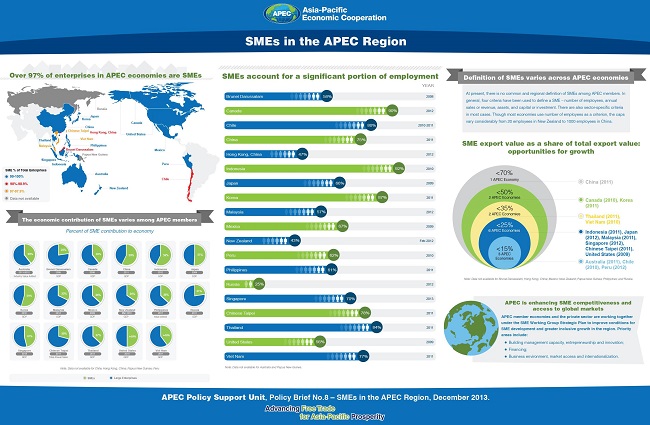Indonesian SMEs Part I: Driving the economy
By Masyitha Baziad November 11, 2015
- SME sector key to GDP growth, but needs to ‘go digital’ to fulfil potential
- Agency tasked with creating awareness says hampered by lack of resources

Untuk membaca berita ini dalam Bahasa Indonesia, silahkan klik di sini.
INDONESIA, South-East Asia’s economic powerhouse from 2010 to 2012, is now facing a slowdown, triggered by the drop in commodity prices – a major source of export income – and the weakening of the rupiah that had led to a decrease in public consumption.
The republic experienced economic growth of 6.2% in 2010 and 2011, declining to 5% in 2014. Indonesia’s Central Bank has estimated that economic growth in 2015 will be in the range of 4.7% to 5.1%.
Part of the slowdown can be attributed to the overall global economic downturn, which is why observers are looking to the Government to identify the domestic sectors that could potentially contribute to economic growth.
“Indonesia needs to start an overall economic restructuring which has a solid foundation and which is not easily swayed by external factors,” said Rosan Perkasa Roeslani, deputy chairman of the Indonesian Chamber of Commerce (Kadin) for Banking and Financial.
Rosan, in an official statement obtained by Digital News Asia (DNA), said that the new economic structure must be based on domestic industry.
“We [need to] develop and support ‘local champions’ – excellent local products and brands that can be a mainstay and enter the global market,” he added, with reference to small and medium enterprises (SMEs).
SMEs must be encouraged because they contribute to “national economic resilience,” he argued, adding that the sector was one of the economic pillars that proved resistant to the 1998 monetary crisis.
Beyond mere ‘resilience,’ SME development and digitalisation can also contribute substantially to the country’s GDP (Gross Domestic Product).
A report by Deloitte Access Economics and Google Indonesia, titled SMEs Powering Indonesia’s Success: The Connected Archipelago’s Growth Engine and released Aug 20, argued that if Indonesian SMEs were to be empowered via digitalisation, the county’s economic growth would see a 2% increment.
The report noted that Indonesia’s economy has been averaging 5% growth per annum. To meet its target of becoming a middle-income country by 2025, it needs to hit GDP growth of 7% – a target that can be achieved with what it describes as ‘SME digital engagement.’

Deloitte Access Economics identifies four levels of digital engagement:
- Offline business: No access to broadband, no computer or smartphone, and does not have a website;
- Basic online business: Broadband access, digital device such as a computer or smartphone, and a static online presence;
- Intermediate online business: Immersed in social media through a combination of integrating websites with social media, live chat or customer threads on websites; and
- Advanced online business: Sophisticated connectivity, social media integration and e-commerce capabilities.
Deloitte Access Economics’ survey of 437 SMEs in Jakarta, Bandung, Semarang, Surabaya, Medan, and Makassar found that 36% fell into the first category (offline); 37% were at No 2 (basic); 18% at No 3 (intermediate); and only 9% in category 4 (advanced).
“SMEs that get online, engage in social media and develop e-commerce capabilities, enjoy significant business benefits in terms of revenue, employment, innovation and competitiveness. Each step up the digital engagement ladder brings benefits,” said the report.
For one, advanced online businesses grew their revenue 80% faster than offline businesses.
“Advanced online businesses are also one and half times more likely to increase the number of people they employ when compared with offline businesses,” and are 17 times more likely to be innovative.
SMEs with higher levels of digital engagement are also likely to be more globally competitive, the report added.

Equitable economic growth
According to Asia Pacific Economic Cooperation (APEC) data, more than 97% of companies across its member economies are SMEs.
In an APEC SME ministerial meeting in the Philippines on Sept 25, the ministers declared that SMEs were key to achieving equitable economic growth.
“Without SMEs in the global market, equitable growth may not be achieved,” the Philippine’s Department of Trade and Industry Secretary Gregory Domingo said in an official statement.
“It’s very important for APEC economies to embrace SMEs, and particularly encourage their ability to take advantage of transnational business opportunities,” he added.
In terms of SME contribution to GDP within APEC, Indonesia and China had the two highest at 59% each. In Indonesia, SMEs also provided 92% of total employment.
According to Indonesia’s Ministry of Cooperatives and SMEs, the country has 57.89 million SME ‘business units,’ or approximately 99.99% of the total number of businesses.
“Indonesia has 250 million people, but the number of entrepreneurs is only 1.65% of the total population,” said the Association of Indonesian SMEs (Akumindo) chairman Ikhsan Ingratubun.
“This number is very small when compared with Malaysia which has 5%, and Singapore with 7%,” he told DNA.
There is great potential here, he argued, adding that the more SMEs there are, the greater the opportunity for economic growth.
Private sector help needed
 For Indonesian SMEs to fulfill their business potential, they need to be aware of the role of technology and digitalisation in supporting their business, Ikhsan (pic) argued.
For Indonesian SMEs to fulfill their business potential, they need to be aware of the role of technology and digitalisation in supporting their business, Ikhsan (pic) argued.
“SMEs have long proven to be the backbone of the economy. To develop them and allow them to reach potential domestic, regional and global markets, SMEs must understand technology and ‘go digital’,” he added.
Ikhsan said that while more SMEs are using technology, many are still unaware of the digital transformation that the greater business world is undergoing.
The Indonesian Government however is aware, and has tasked Akumindo with reaching out to the nearly 58 million SMEs in the country on the need to be digitally engaged.
Unfortunately, limited human resources have hampered Akumindo from carrying out this mandate, according to Ikhsan.
“We are trying our best … but we also realise our limits in terms of scale and capabilities,” he said, urging private sector companies involved in the technology and digital space to help Akumindo in its task.
“This cannot be driven only by the Government. The private sector has the know-how, and in a more detailed and strategic way,” he added.
Ikhsan also said that almost all SMEs in Indonesia were aware of the huge business potential of going digital, it was only they did not know how and where to start.
Related Stories:
Blibli.com to bring Indonesia’s SMEs into the digital age
Made-in-Malaysia platform out to solve the SME tech dilemma
APAC digital transformation to ‘scale massively’ in 2017: IDC
Huge opportunities for SMEs in cross-border e-commerce: PayPal
For more technology news and the latest updates, follow us on Twitter, LinkedIn or Like us on Facebook.



